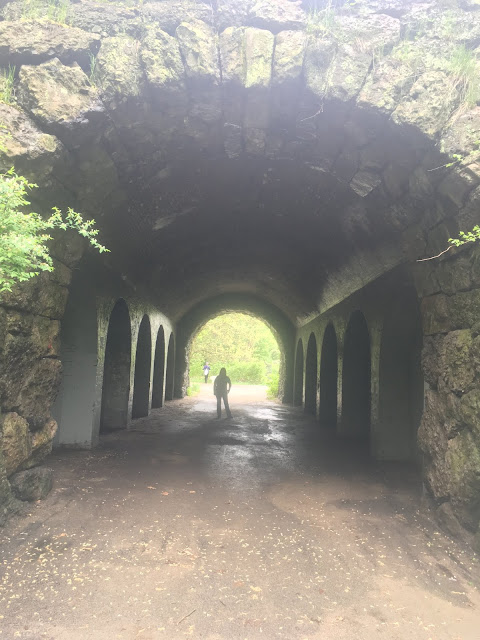Anyone can be an explorer, and anyone can go on an adventure. It doesn't have to involve things like bushwhacking to the top of some mountain in search of
airplane wreckage, roaming through underground
WWII bunkers, or even going eyeball to eyeball with porcupines
deep within a mineshaft. Exploring can be as easy as spending a day wandering one of New England's most historic and unique parks.
If you enjoy ruins, trails, history, or all of the above, then Franklin Park of Boston deserves a place right at the top of your to-do list. Several different areas make up this park, and while each alone would have made the hour and a half drive from our house worthwhile, in this case you get them all together in one giant playground.
Overlook shelter Ruins
A short walk down one of the park's well-maintained trails will bring you to the Overlook Shelter Ruins, an area that once served as a site for sporting events. The field where games took place was overlooked by a building with a viewing area for spectators. In the 1940s this building burned to the ground, and what's left of the area today are several sets of stairs, a couple seemingly random walls, and one very picturesque tunnel.
99 Steps
There are plenty of trails to explore at Franklin Park, but make sure to look for one that contains something called the 99 Steps. This trail is just what it sounds like - you'll climb for a bit, walk flat surface for a bit, climb for a bit more, and continue this way until you've accumulated a total of 99 steps. Although I lost count halfway through, I exhaled at the top and announced that yup, that was indeed 99.
As you're climbing be on the looking for these old signs, and remember Tina, no "harangues".
Ellicott Arch
Franklin Park is bisected by a road called Circuit Drive, and although you can simply walk across this road at any point, don't be fooled. Instead you want to follow a trail that leads to Ellicott Arch. This beautiful tunnel brings you underneath Circuit Drive, and its many sealed doors will have you wondering what sort of treasures are hiding behind them.
Schoolmaster Hill Ruins
Although I was familiar with the name Ralph Waldo Emerson prior to this trip, until visiting this next spot I could only have guessed at what he was famous for. High school is just too far in the past for me. But as this plaque will tell you, Emerson was among other things a poet, and lived for a period of time on this very spot.
In later years his residence was turned into a clubhouse for the golf course it overlooked, but in the 1930s it was destroyed by fire, leaving behind pillars and stairs that are now referred to as the Ruins of Schoolmaster Hill.
As much as I'd like to pretend these ruins were something we had to trek miles through the woods to find, they are actually right in the center of the park, next to the road. Panning the picture just a little will show you that on the day we went, this was home-base for volunteers of a 5k that was taking place.
Abandoned Bear Cages
This final area was so cool I considered making it a post of its own. The Franklin Park Zoo opened in 1912 and remains active to this day, however in the 1950s it underwent an extensive rehab, and not all exhibits made the cut. Left outside the new and improved zoo were these bear cages, which now sit rotting and abandoned on the north side of the park.
We didn't know the purpose of several round cages that stand within the exhibits, but they looked just about the perfect size for someone to hang out in.
I was able to crouch down and sneak my camera into the bear tunnels, and although bars prevented me from accessing them I was able to see the network of corridors bears once roamed through.
To find the location of each of these spots, visit our
Adventure Map and zoom in just south of Boston until you pinpoint Franklin Park. All of them are within a miles walk from each other and marked by a blue star, and with this information, the only thing left for your own adventure is a full tank of gas and a sunny afternoon.




















































